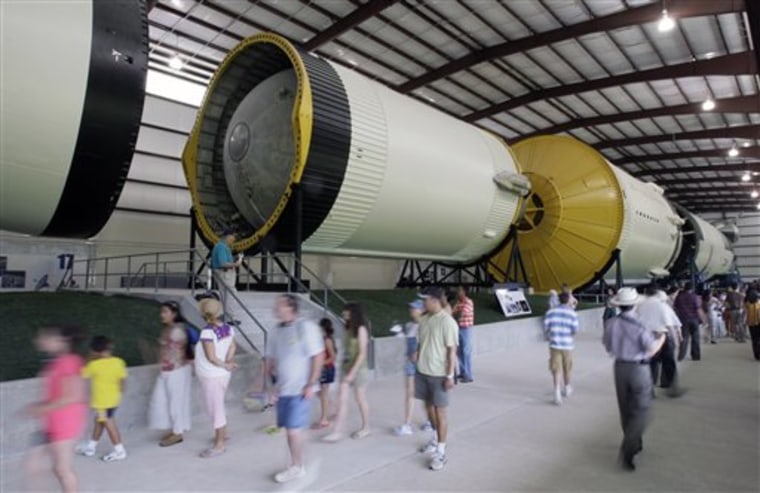Dwarfed by the Saturn V rocket's immense size, 10-year-old Adam Brauscum stood in awe as his father described how such massive machinery carried man to the moon.
"It's so big," Adam said earlier this week as visitors around him snapped photographs of the newly refurbished rocket. "It's hard to imagine that took men to the moon."
The Saturn V on display outside Johnson Space Center for two decades would be 30 stories high if stood upright. But the rocket, one of the most powerful ever built, was no match for the city's stifling humidity. A two-year, $5 million restoration was culminating in reopening ceremonies Friday — 38 years to the day after men first walked on the moon.
The rocket, which is already open to visitors, is now housed inside a climate-controlled, barn-like building near the entrance to the space center. Posters alongside the rocket's different sections explain their function to visitors.
Former astronaut Alan Bean, who walked on the moon in 1969 on the Apollo 12 mission, said preserving the rocket was important because it is a symbol of America's success in space exploration and the country's innovative spirit.
"It's inspirational to look at it and think that human beings just like us conceived it, designed it and built it," he said. "It shows human beings at their best."
Saturn V rockets were launched 13 times from 1967 to 1973. Eight missions traveled to the moon, and six landed there. A Saturn V also put Skylab, America's first space station, into orbit in 1973.
Houston's moist air and rain began rotting the aluminum underside of the Johnson Space Center rocket, which is on loan from the Smithsonian's National Air and Space Museum collection. Owls and other animals moved in to the gaping holes left by rust, mold and mildew.
"It was in poor condition and it was getting much worse," said Allan Needell, curator of the Apollo Collection at the National Air and Space Museum. "It was to the point where if we didn't intervene now, future attempts to save it would require replacing a lot of the original materials. We wanted to save as much of the original material as possible."
The rocket never launched because its mission, Apollo 18, was canceled. It is one of only three on display, the others being at the Kennedy Space Center in Florida and the U.S. Space and Rocket Center in Huntsville, Ala.
"Probably nothing really symbolizes the uniqueness of scale and enterprise involved with the space program as much as the Saturn V rocket," Needell said. "It would be tragic if people could understand the scale of it only through pictures or movies. There is nothing like looking at the real thing."
